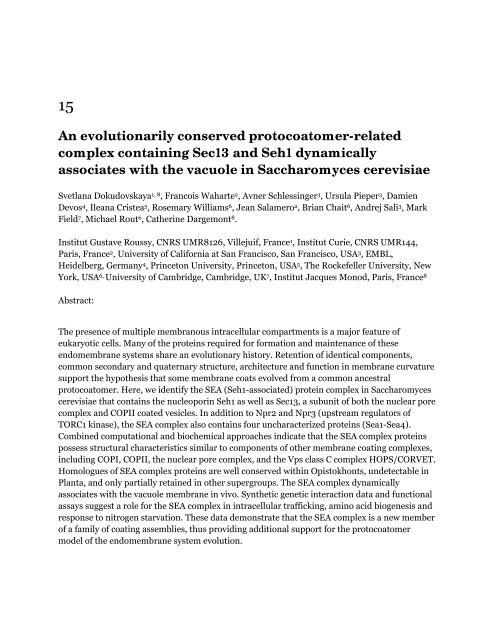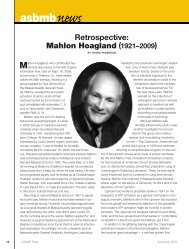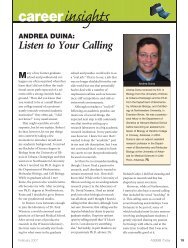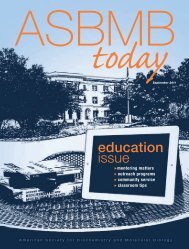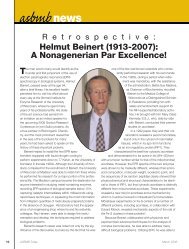View Program - asbmb
View Program - asbmb
View Program - asbmb
- TAGS
- program
- asbmb
- www.asbmb.org
You also want an ePaper? Increase the reach of your titles
YUMPU automatically turns print PDFs into web optimized ePapers that Google loves.
15<br />
An evolutionarily conserved protocoatomer-related<br />
complex containing Sec13 and Seh1 dynamically<br />
associates with the vacuole in Saccharomyces cerevisiae<br />
Svetlana Dokudovskaya 1, 8 , Francois Waharte 2 , Avner Schlessinger 3 , Ursula Pieper 3 , Damien<br />
Devos 4 , Ileana Cristea 5 , Rosemary Williams 6 , Jean Salamero 2 , Brian Chait 6 , Andrej Sali 3 , Mark<br />
Field 7 , Michael Rout 6 , Catherine Dargemont 8 .<br />
Institut Gustave Roussy, CNRS UMR8126, Villejuif, France 1 , Institut Curie, CNRS UMR144,<br />
Paris, France 2 , University of California at San Francisco, San Francisco, USA 3 , EMBL,<br />
Heidelberg, Germany 4 , Princeton University, Princeton, USA 5 , The Rockefeller University, New<br />
York, USA 6, University of Cambridge, Cambridge, UK 7 , Institut Jacques Monod, Paris, France 8<br />
Abstract:<br />
The presence of multiple membranous intracellular compartments is a major feature of<br />
eukaryotic cells. Many of the proteins required for formation and maintenance of these<br />
endomembrane systems share an evolutionary history. Retention of identical components,<br />
common secondary and quaternary structure, architecture and function in membrane curvature<br />
support the hypothesis that some membrane coats evolved from a common ancestral<br />
protocoatomer. Here, we identify the SEA (Seh1-associated) protein complex in Saccharomyces<br />
cerevisiae that contains the nucleoporin Seh1 as well as Sec13, a subunit of both the nuclear pore<br />
complex and COPII coated vesicles. In addition to Npr2 and Npr3 (upstream regulators of<br />
TORС1 kinase), the SEA complex also contains four uncharacterized proteins (Sea1-Sea4).<br />
Combined computational and biochemical approaches indicate that the SEA complex proteins<br />
possess structural characteristics similar to components of other membrane coating complexes,<br />
including COPI, COPII, the nuclear pore complex, and the Vps class C complex HOPS/CORVET.<br />
Homologues of SEA complex proteins are well conserved within Opistokhonts, undetectable in<br />
Planta, and only partially retained in other supergroups. The SEA complex dynamically<br />
associates with the vacuole membrane in vivo. Synthetic genetic interaction data and functional<br />
assays suggest a role for the SEA complex in intracellular trafficking, amino acid biogenesis and<br />
response to nitrogen starvation. These data demonstrate that the SEA complex is a new member<br />
of a family of coating assemblies, thus providing additional support for the protocoatomer<br />
model of the endomembrane system evolution.


